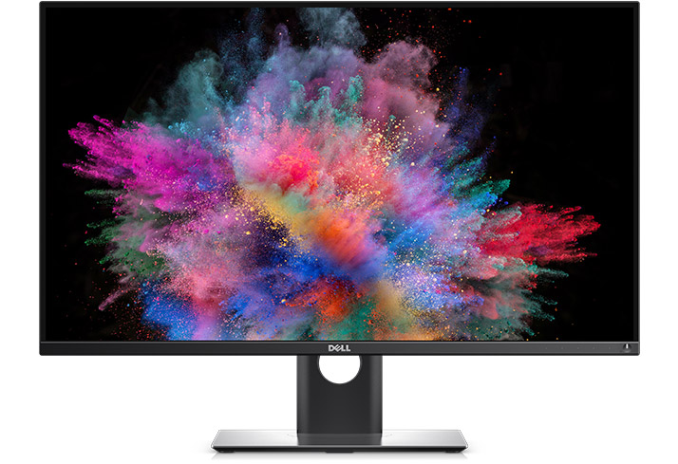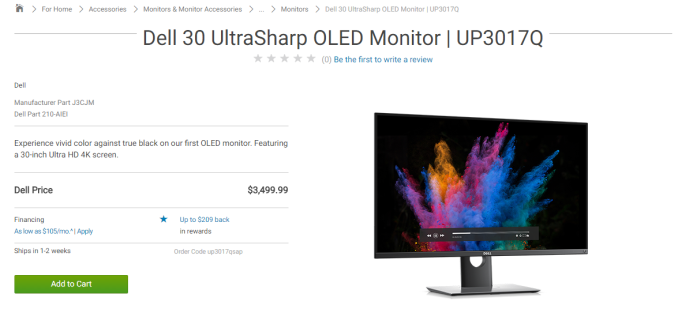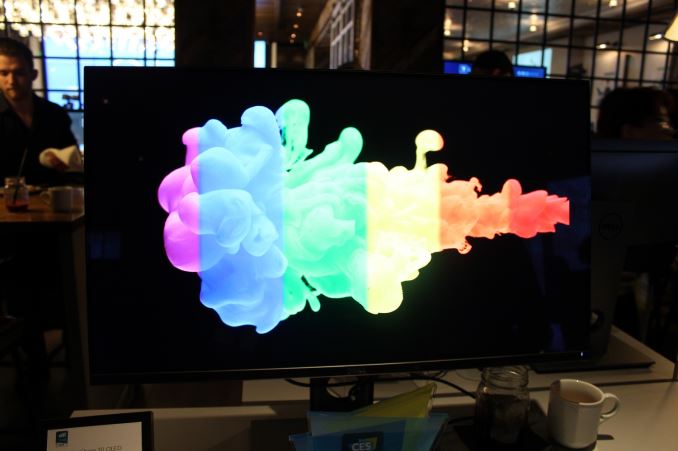Dell’s Ultrasharp 30-inch 4K OLED Now On Sale: UP3017Q for $3500
by Ian Cutress & Brett Howse on April 13, 2017 3:00 AM EST
One of the biggest bits of news to come out of CES 2016, over a year ago, was Dell announcing a new beacon in OLED monitors: a 3840x2160 panel measuring 30-inch diagonal using an OLED display was set to come to market. When we reported on it back at CES, they stated a $4999 price point for March 31st. What happened over the next 12 months was interesting: some journalists doing ‘hands-on’ reviews at tech shows, but nothing coming to retail, followed by plenty of CES 2017 news that the display had been shelved due to image quality issues. Well roll around another quarter, and it seems that Dell is ready to sell it, and shipping for this $3499 beast is only 1-2 weeks away.
| Specifications of the Dell Ultrasharp UP3017Q | |
| UP3017Q | |
| Panel | 76.19cm (30-inch) |
| Native Resolution | 3840 × 2160 |
| Maximum Refresh Rate | 60 Hz |
| Response Time | 0.1 ms (black to white) |
| Brightness | 300 cd/m² (typical) 0.0005 cd/m² (minimum) |
| Contrast | 1000000:1 |
| Viewing Angles | 178°/178° horizontal/vertical |
| Pixel Pitch | 0.1713 mm² |
| Pixel Density | 147 ppi |
| Display Colors | 1.07 billion |
| Color Gamut Support | Adobe RGB: 100% Rec 709: 100% DCI-P3: 97.5% Rec2020: 85.8% |
| Stand | Tilt (5~21°), pivot (+90°, -90°) and height (100 mm) adjustable |
| Inputs | 1 × DisplayPort 1.2 1 × HDMI 2.0 1 × USB Type-C (DP 1.2. PD 100W). |
| Audio | None |
| Launch Price | $3499 |
The Dell UltraSharp UP3017Q is a 30-inch display with a 3840×2160 resolution, response time of 0.1ms, and is set to run at 60 Hz (not 120 Hz as some outlets originally reported). The monitor can reproduce 1.07 billion colors (in this case we assume 10-bit), it covers 100% of Adobe RGB color space as well as and 97.8% of DCI-P3 color space (used for digital movie projection by the U.S. movie industry and is expected to be adopted in televisions and in home cinema), and 85.8% of Rec2020. The manufacturer declares a 1,000,000:1 dynamic contrast ratio, due to the characteristic black of OLED displays.
The UltraSharp UP3017Q is a thin monitor with narrow bezels, but not remarkably thin like OLED TVs, due to the internal power supply unit as well as complex logic inside. The monitor features a mini DisplayPort (mDP) 1.2 connector, an HDMI 2.0 port, and a USB type-C port which can be used for video and data connectivity, as well as power delivery up to 100W.
The Emissive electroluminescent layer in an organic light-emitting diode is made of an organic compound that emits light in response to an electric current. The organic semiconductor layer is situated between two electrodes and does not require a backlight. As a result, it can display deep black levels unlike LCD panels which also use various kinds of backlighting. Curved TVs and monitors are also possible, since the emissive electroluminescent layer is very thin and can take different shapes.
While OLED technology can deliver deep blacks, high contrast ratio and exceptional colors, it is not free of drawbacks. Colors can shift over time, and the organic layer may degrade over prolonged amount of time. To keep the lifespan of the OLED panel maximized inside the UltraSharp UP3017Q, Dell originally advertised a special integrated presence detector into the front panel of the display, which switches the monitor off when nobody uses it, though it is not clear if this is still present. Another disadvantage of OLEDs is a possibility of static image burn-in. The UP3017Q has a special pixel-shifting technology to try and inhibit this.
The Dell UltraSharp 30 OLED monitor will cost $3499 and is available to order in the United States. The display at this point is only aimed at professionals that work in color-critical environments such as graphic arts and photography. However, due to the colors, contrast, and ultra-fast response time, the UltraSharp UP3017Q will be a dream display for gamers, prosumers and other users that value quality.
OLED panels are considerably more expensive to produce than modern LCD panels, partly because of lower yields. In 2015, an executive from LG Electronics said that yields of OLED panels had reached 80% and would continue to grow. At the International CES 2016, Kwon Bong-suk, the head of LG’s TV business, said that the company had cut prices of OLED TVs in the U.S. by 45% late in 2015. As a result, LG expected sales of OLED televisions to triple in 2016. Price reduction of OLED TVs indicates that production costs of organic light-emitting diode panels are going down. Perhaps, over time, the Dell UltraSharp UP3017Q will also become more affordable, or Dell will release an OLED display for a wider audience.
Original Source: @ChrisK101010
Source: Dell













65 Comments
View All Comments
nathanddrews - Friday, April 14, 2017 - link
LG OLED TVs, specifically the 2016 and 2017 models can accept a maximum input resolution and refresh of 4K60 4:4:4. The native display refresh rate is 120Hz, so content less than that is multiplied to 120Hz (or 100Hz for PAL).Some LG OLED panels have been shown displaying up to 120fps video content natively in demos of HFR video.
Guspaz - Thursday, April 13, 2017 - link
LG cheats when it comes to OLEDs. To increase yields and lifespans, they don't actually use an RGB OLED panel. The entire OLED panel is nothing but white subpixels, on top of which they slap a colour filter grid like you'd see in an LCD panel.The upside is that this technique reduced manufacturing complexity and cost and increased yields, which is why LG was able to keep making OLED TVs when every other company (including Samsung and Sony) stopped making them due to yield issues. The neutral part is that they still have the same advantages in terms of contrast ratio and respones time as an RGB OLED panel. The downside is that they're much less power efficient (due to all the light blocked by the filters) and don't have quite the same quality of colour as native RGB could achieve.
Inteli - Thursday, April 13, 2017 - link
Until Blue OLEDs stop dying way sooner than either Red or Green OLEDs, I'd much rather have White OLEDs than RGBOLEDsrmm584 - Thursday, April 13, 2017 - link
They could combing RGBW tech with Quantum dot filters solve those issues.rmm584 - Thursday, April 13, 2017 - link
*They could combine RGBW tech with Quantum dot filter to solve those issues.cocochanel - Saturday, April 15, 2017 - link
Thanks for the info !The other day I was at a Best Buy store looking at some TV's. Maybe it's just me, but I thought the Samsung 4k with Quantum Dot looked a bit better than LG's with OLED. Even the top of the line Sony's 4k looked better. I know, it's subjective of course.
Kamamura - Tuesday, April 18, 2017 - link
It's just you. The "Quantum dot" technology is just quantum dots used as a backlight with LCD filter over it, thus inheriting all the disadvantages of LCD - low response times and bad viewing angles, while gaining wider color gamut compared to WLED LCD, and longer lifespan compared to OLED.However, when it comes to image quality, they will always be inferior in terms of contrast, response times and viewing angles.
Gothmoth - Thursday, April 13, 2017 - link
will wait for the first tests of the retail models. for around 2200 euro i would think about buying one.tigz1218 - Thursday, April 13, 2017 - link
If I'm gonna drop that price on a monitor it'd better have 120hz with all those other features. That's a big feature missing for me.Inteli - Thursday, April 13, 2017 - link
The only way I'd consider buying this is if it uses an LG WOLED panel or if they have seriously improved the lifespan of blue OLEDs (enough that it matches up with red amd green) if this uses a Samsung Panel.My last product with a Samsung OLED screen was tinted yellow after a couple of years, and I don't want to spend $3500 on a monitor that does the same thing.
Also, I know this isn't a consumer monitor but it seems like this could be HDR capable, and should beat the FALED LCD monitors pretty handily.